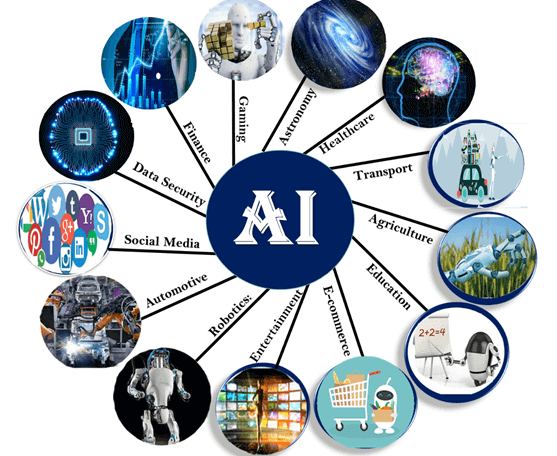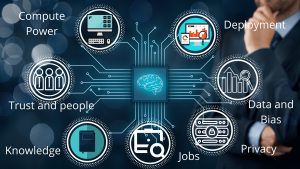Artificial Intelligence (AI) has emerged as a transformative force reshaping industries and revolutionizing daily life. In this blog post, we'll explore the fascinating world of AI, its applications, future prospects, and its profound impact on both businesses and individuals.
At its core, AI refers to the simulation of human intelligence processes by machines, enabling them to perform tasks that typically require human intelligence, such as learning, reasoning, problem-solving, and decision-making. AI encompasses various subfields, including machine learning, natural language processing, computer vision, and robotics.
AI finds applications across diverse sectors, from healthcare and finance to retail and manufacturing. In healthcare, AI-powered systems analyze medical images, diagnose diseases, and personalize treatment plans. In finance, AI algorithms predict market trends, detect fraud, and optimize investment portfolios. In retail, AI enhances customer experiences through personalized recommendations and chatbots.
The future of AI holds immense promise, with ongoing advancements and innovations driving its evolution. One exciting area of development is autonomous vehicles, where AI enables cars to navigate and make decisions without human intervention. Additionally, AI-driven virtual assistants are becoming increasingly sophisticated, offering personalized assistance and streamlining daily tasks.
For businesses, AI presents unparalleled opportunities for innovation, efficiency, and growth. By leveraging AI-powered analytics, organizations can gain valuable insights from vast amounts of data, enabling data-driven decision-making and predictive analytics. AI-driven automation streamlines business processes, reduces costs, and enhances productivity, freeing up human resources to focus on higher-value tasks.
AI enables businesses to extract valuable insights from large volumes of data, empowering decision-makers to make informed and data-driven choices. Advanced analytics powered by AI algorithms help identify patterns, trends, and correlations within data sets, facilitating better strategic planning and resource allocation.
AI-driven personalization allows businesses to tailor products, services, and marketing efforts to individual customer preferences and behaviors. By analyzing customer data in real-time, AI systems can deliver personalized recommendations, targeted advertisements, and customized interactions, enhancing the overall customer experience and fostering loyalty.
AI algorithms leverage historical data to predict future outcomes, enabling businesses to anticipate market trends, customer demands, and potential risks. Predictive analytics tools powered by AI help optimize inventory management, pricing strategies, and supply chain operations, improving efficiency and reducing costs.
AI-powered automation streamlines repetitive tasks and workflows, eliminating manual errors, reducing operational costs, and increasing productivity. Robotic Process Automation (RPA) software, driven by AI and machine learning, automates routine business processes such as data entry, invoice processing, and customer support, freeing up human resources to focus on higher-value tasks.
AI-based risk management systems analyze vast amounts of data to identify and mitigate potential risks, such as cybersecurity threats, financial fraud, and regulatory compliance issues. Machine learning algorithms detect anomalous patterns and suspicious activities in real-time, enabling businesses to proactively address security breaches and safeguard their assets and reputation.
Businesses that harness AI effectively gain a competitive edge by leveraging cutting-edge technologies to innovate, differentiate, and adapt to changing market dynamics. AI enables organizations to develop innovative products and services, optimize business processes, and explore new revenue streams, positioning them for long-term success and growth in today's digital economy.
In our daily lives, AI has become ubiquitous, from voice-activated virtual assistants like Siri and Alexa to recommendation systems on streaming platforms like Netflix and Spotify. AI-powered smart home devices automate household tasks, such as adjusting thermostats, managing lighting, and ordering groceries. Wearable devices equipped with AI monitor health metrics, track fitness activities, and provide personalized insights.
Despite its transformative potential, AI also raises ethical, privacy, and societal concerns. Issues such as bias in AI algorithms, data privacy, and job displacement due to automation require careful consideration and regulation. It's crucial to ensure responsible development and deployment of AI technologies to mitigate potential risks and maximize societal benefits.
Artificial Intelligence is revolutionizing the way we live, work, and interact with the world around us. From business innovation to daily conveniences, AI is driving unprecedented advancements and reshaping our future. By embracing AI responsibly and ethically, we can harness its transformative power to create a better, more intelligent world for generations to come.
As AI continues to evolve and expand its capabilities, the possibilities are truly limitless, and the journey ahead promises to be nothing short of extraordinary.



